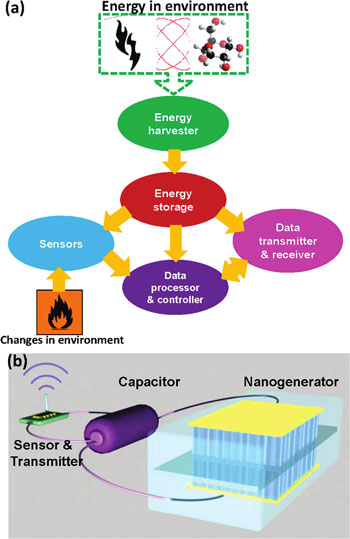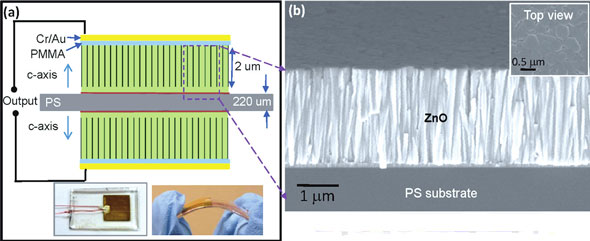| Posted: Jun 01, 2011 | |
First self-powered nanosystem with wireless data transmission |
|
| (Nanowerk Spotlight) Fabrication of a single nanodevice is no longer the state of the art in nanotechnology. The leading edge – and also currently the most challenging area in nanotechnology – is research that leads to a self-powered nanoscale system that is driven by the energy harvested from its environment and that can perform its work independently and sustainable. This is a key step toward self-powered nanotechnology, which is vitally important for medical science, environmental monitoring, defence technology and even personal electronics. Not to mention that it will lead to practically usable nanotechnology devices. | |
| Probably the leading team that is driving forward the work on nanogenerators for converting mechanical energy into electricity is Zhong Lin Wang's group at Georgia Tech. We have covered their work before in articles about nanopiezotronics and nanogenerators that can harvest energy from body movements like breathing and heartbeats. | |
| In new work reported in the May 23, 2011 online edition of Nano Letters ("Self-Powered System with Wireless Data Transmission"), Wang's team has now provided the first demonstration that a nanogenerator can be strong enough to power a device with the capability of sensing, data processing and wireless data transmission. This is a powerful demonstration of the self-powered nanosystem and its potential applications. | |
| "We demonstrate the first self-powered system driven by a nanogenerator that works wirelessly and independently for long-distance data transmission" Wang tells Nanowerk. "The power generated by a nanogenerator may not be sufficient to continuously drive a device, but an accumulation of charges generated over a period of time is sufficient to drive the device to work for a few seconds. This is very suitable for applications in the fields of sensing, infrastructure monitoring, and sensor networks." | |
| He explains that a common characteristic for these sensing applications is that there are so many sensors in the system, and each sensor is expected to work independently and wirelessly, but all of them will be linked through a network/Internet. | |
 |
|
| Schematic diagram of the integrated self-powered system. (a) An integrated system can be divided into five modules: energy harvester, energy storage, sensors, data processor and controller, and data transmitter and receiver. (b) The prototype of an integrated self-powered system by using a nanogenerator as the energy harvester. (Reprinted with permission from American Chemical Society) | |
| "Each sensor is not required to work continuously and simultaneously, instead, it will have a 'blinking' working mode with a standby status and active status" says Wang. "The standby mode is normally longer, while the active mode is shorter. The energy scavenged and stored during the standby status can be used to drive it in the active mode. This means that these sensors periodically sample from their working environment and transmit data within a fraction of second. We can use the nanogenerator to harvest energy from the environment and store most of the energy when the sensor is in the standby mode. Then the collected energy will be used to trigger the sensor and then process and transmit the data in the active mode." | |
| The nanogenerator fabricated by Wang's team is a free-standing cantilever beam that consists of a five-layer structure: a flexible polymer substrate; densely packed zinc oxide nanowire textured films on its top and bottom surfaces; and electrodes on the surfaces. | |
| When it was strained to 0.12% at a strain rate of 3.56 % S-1, the measured output voltage reached 10 V, and the output current exceeded 0.6 µA (corresponding power density 10 mW/cm3). | |
 |
|
| Nanogenerator fabrication and its working mechanism. (a) Fabrication process of the nanogenerator. The lower right parts are photos of a fabricated nanogenerator after packaging. The bending of the nanogenerator shows its good mechanical flexibility. (b) Cross section SEM image of the as-grown nanowire textured film on the substrate. The insert is the top view of the nanowire film. (Reprinted with permission from American Chemical Society) | |
| To prove the possibility of wireless data transmission, the team put together a system by integrating a nanogenerator, rectification circuit, capacitor for energy storage, sensor, and radio frequency data transmitter. By storing the energy generated by the nanogenerator, Wang's team demonstrated a self-powered system that can work independently and wirelessly. | |
| "Wireless signals sent out by the system were detected by a commercial radio at a distance of 5-10 meters" says Wang. "This the first demonstration of using a nanogenerator for a practical application. It will open many opportunities." | |
| Wang points out that these kinds of nanogenerators are a key step towards novel, cost-effective, adaptable and mobile applications in nanotechnology. | |
| "The principle that we demonstrated can be further optimized and improved for enhancing output power and establishing a basic method for harvesting/recycling energy from the environment such as body movement, mechanical vibration, and sonic waves" he says. | |
 By
Michael
Berger
– Michael is author of three books by the Royal Society of Chemistry:
Nano-Society: Pushing the Boundaries of Technology,
Nanotechnology: The Future is Tiny, and
Nanoengineering: The Skills and Tools Making Technology Invisible
Copyright ©
Nanowerk LLC
By
Michael
Berger
– Michael is author of three books by the Royal Society of Chemistry:
Nano-Society: Pushing the Boundaries of Technology,
Nanotechnology: The Future is Tiny, and
Nanoengineering: The Skills and Tools Making Technology Invisible
Copyright ©
Nanowerk LLC
|
|
|
Become a Spotlight guest author! Join our large and growing group of guest contributors. Have you just published a scientific paper or have other exciting developments to share with the nanotechnology community? Here is how to publish on nanowerk.com. |
|
